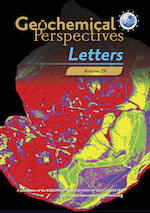Titanium isotope constraints on the mafic sources and geodynamic origins of Archean crust
Affiliations | Corresponding Author | Cite as | Funding information- Share this article





-
Article views:171Cumulative count of HTML views and PDF downloads.
- Download Citation
- Rights & Permissions
top
Abstract
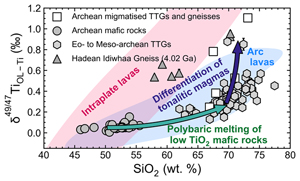
Figures
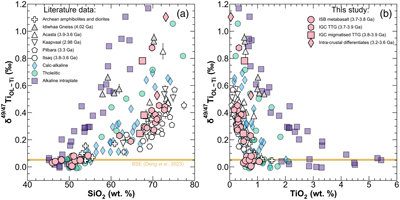 Figure 1 δ49/47Ti compositions of ISB metabasalts, IGC tonalites and intra-crustal differentiates, with other Hadean-Archean rocks, compared to Phanerozoic lavas from different tectonic settings versus (a) SiO2 and (b) TiO2. Literature sources are given in the Supplementary Information, Table S-11. | 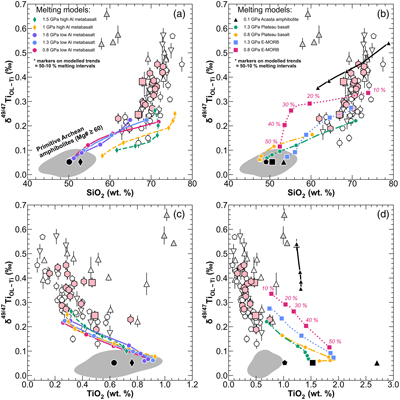 Figure 2 δ49/47Ti versus SiO2 and TiO2 for partial melting of high and low Al Isua metabasalts at 0.8–1.6 GPa (a and c); and partial melting of E-MORB and primitive plateau basalt at 0.8–1.3 GPa (b and d) superimposed on to δ49/47Ti data for Hadean-Archean TTGs (pink, white and grey symbols; see Fig. 1 for the legend). Shaded grey field represents δ49/47Ti range of primitive Archean amphibolites (Mg# > 60) defined by a 0.95 probability density contour. Black symbols indicate the starting composition for each model. Symbols on modelled trends represent melting intervals between 50–10 %. Modelling details are given in the Supplementary Information. | 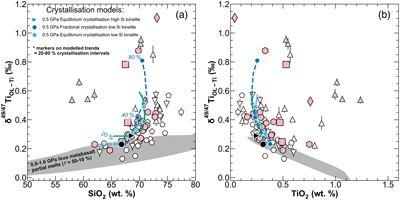 Figure 3 δ49/47Ti versus (a) SiO2 and (b) TiO2 for equilibrium (solid lines) and fractional crystallisation (dashed line) of tonalitic melts at 0.5 GPa compared to δ49/47Ti of Hadean-Archean TTGs (pink, white and grey symbols; see Fig. 1 for legend). Shaded grey field represents the δ49/47Ti range of modelled 50–10 % partial melts of Isua metabasalts from Figure 2 defined by a 0.95 probability density contour. Black symbols indicate the starting composition for each model. Symbols on modelled trends represent crystallisation intervals between 20–80 %. Modelling details are given in the Supplementary Information. | 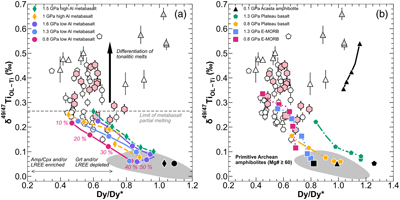 Figure 4 δ49/47Ti versus Dy/Dy* (after Davidson et al., 2013) for partial melting of (a) high and low Al Isua metabasalts at 0.8–1.6 GPa, and (b) partial melting of E-MORB and primitive plateau basalt at 0.8–1.3 GPa superimposed on to δ49/47Ti data for Hadean-Archean TTGs (pink, white and grey symbols, refer to Fig. 1 for the symbol legend). Shaded grey field represents the δ49/47Ti range of primitive Archean amphibolites (Mg# > 60) defined by a 0.95 probability density contour. Black symbols indicate the starting composition for each model. Symbols on modelled trends represent melting intervals between 50–10 %. Modelling details are given in the Supplementary Information. |
| Figure 1 | Figure 2 | Figure 3 | Figure 4 |
top
Introduction
Remnants of Archean juvenile continental crust are preserved in the form of sodic granitoids collectively known as Tonalite-Trondhjemite-Granodiorites (TTG). There is ongoing debate about the origin of these incomplete remnants, leading to varying interpretations over the responsible tectonic regime. TTG formation hypotheses are broadly divided between two end members that involve partial melting of thickened, hydrated mafic crust in 1) a horizontal tectonic regime, possibly analogous to modern subduction (e.g., Foley et al., 2002
Foley, S., Tiepolo, M., Vannucci, R. (2002) Growth of early continental crust controlled by melting of amphibolite in subduction zones. Nature 417, 837–840. https://doi.org/10.1038/nature00799
), or 2) a non-uniformitarian regime such as oceanic plateaux (e.g., Nair and Chacko, 2008Nair, R., Chacko, T. (2008) Role of oceanic plateaus in the initiation of subduction and origin of continental crust. Geology 36, 583–586. https://doi.org/10.1130/G24773A.1
). Furthermore, despite extensive geochemical and experimental evidence supporting polybaric dehydration melting of hydrated mafic crust as a formation mechanism of juvenile TTG magmas (e.g., Barker and Arth, 1976Barker, F., Arth, J.G. (1976) Generation of trondhjemitic-tonalitic liquids and Archean bimodal trondhjemite-basalt suites. Geology 4, 596–600. https://doi.org/10.1130/0091-7613(1976)4%3C596:GOTLAA%3E2.0.CO;2
; Rapp et al., 1991Rapp, R.P., Watson, E.B., Miller, C.F. (1991) Partial melting of amphibolite/eclogite and the origin of Archean trondhjemites and tonalites. Precambrian Research 51, 1–25. https://doi.org/10.1016/0301-9268(91)90092-O
), many TTGs have undergone subsequent fractional crystallisation (e.g., Laurent et al., 2020Laurent, O., Björnsen, J., Wotzlaw, J.-F., Bretscher, S., Pimenta Silva, M., Moyen, J.-F., Ulmer, P., Bachmann, O. (2020) Earth’s earliest granitoids are crystal-rich magma reservoirs tapped by silicic eruptions. Nature Geoscience 13, 163–169. https://doi.org/10.1038/s41561-019-0520-6
), obscuring the nature of their mafic protolith.Mass dependent isotope variations of titanium (expressed as δ49/47Ti) have recently been utilised as a novel tool to investigate magmatic differentiation (Millet et al., 2016
Millet, M.-A., Dauphas, N., Greber, N.D., Burton, K.W., Dale, C.W., Debret, B., Macpherson, C.G., Nowell, G.M., Williams, H.M. (2016) Titanium stable isotope investigation of magmatic processes on the Earth and Moon. Earth and Planetary Science Letters 449, 197–205. https://doi.org/10.1016/j.epsl.2016.05.039
; Greber et al., 2017Greber, N.D., Dauphas, N., Bekker, A., Ptáček, M.P., Bindeman, I.N., Hofmann, A. (2017) Titanium isotopic evidence for felsic crust and plate tectonics 3.5 billion years ago. Science 357, 1271–1274. https://doi.org/10.1126/science.aan8086
; Deng et al., 2019Deng, Z., Chaussidon, M., Savage, P., Robert, F., Pik, R., Moynier, F. (2019) Titanium isotopes as a tracer for the plume or island arc affinity of felsic rocks. Proceedings of the National Academy of Sciences 116, 1132–1135. https://doi.org/10.1073/pnas.1809164116
; Aarons et al., 2020Aarons, S.M., Reimink, J.R., Greber, N.D., Heard, A.W., Zhang, Z., Dauphas, N. (2020) Titanium isotopes constrain a magmatic transition at the Hadean-Archean boundary in the Acasta Gneiss Complex. Science Advances 6, eabc9959. https://doi.org/10.1126/sciadv.abc9959
; Hoare et al., 2020Hoare, L., Klaver, M., Saji, N.S., Gillies, J., Parkinson, I.J., Lissenberg, C.J., Millet, M.-A. (2020) Melt chemistry and redox conditions control titanium isotope fractionation during magmatic differentiation. Geochimica et Cosmochimica Acta 282, 38–54. https://doi.org/10.1016/j.gca.2020.05.015
), and can be applied to test petrogenetic models of TTG formation. Based on these studies it has been postulated that titanium isotope fractionation is mainly driven by the sequestration of light isotopes into Fe-Ti oxides (ilmenite, magnetite, and rutile) where Ti occupies VI-fold coordination (e.g., Hoare et al., 2022Hoare, L., Klaver, M., Muir, D.D., Klemme, S., Barling, J., Parkinson, I.J., Lissenberg, C.J., Millet, M.-A. (2022) Empirical and experimental constraints on Fe-Ti oxide-melt titanium isotope fractionation factors. Geochimica et Cosmochimica Acta 326, 253–272. https://doi.org/10.1016/j.gca.2022.02.011
; Johnson et al., 2023Johnson, A.C., Zhang, Z.J., Dauphas, N., Rudnick, R.L., Foden, J.D., Toc, M. (2023) Redox and mineral controls on Fe and Ti isotopic fractionations during calc-alkaline magmatic differentiation. Geochimica et Cosmochimica Acta 355, 1–12. https://doi.org/10.1016/j.gca.2023.06.016
). Consequently, melts in equilibrium with these phases are enriched in heavy Ti isotopes, which occupy lower coordination (VI- and V-fold). Furthermore, δ49/47Ti variations of evolved magmas from different geodynamic settings show differences (Fig. 1). Silicic melts from reduced, H2O-poor, Ti-rich intra-plate magmas have higher δ49/47Ti relative to arc magmas at a given SiO2 content (Fig. 1; Deng et al., 2019Deng, Z., Chaussidon, M., Savage, P., Robert, F., Pik, R., Moynier, F. (2019) Titanium isotopes as a tracer for the plume or island arc affinity of felsic rocks. Proceedings of the National Academy of Sciences 116, 1132–1135. https://doi.org/10.1073/pnas.1809164116
; Hoare et al., 2020Hoare, L., Klaver, M., Saji, N.S., Gillies, J., Parkinson, I.J., Lissenberg, C.J., Millet, M.-A. (2020) Melt chemistry and redox conditions control titanium isotope fractionation during magmatic differentiation. Geochimica et Cosmochimica Acta 282, 38–54. https://doi.org/10.1016/j.gca.2020.05.015
). In alkaline intra-plate magmas, larger Ti isotope fractionation is driven by significant Fe-Ti oxide crystallisation, in contrast to hydrous subduction zone magmas where only low Ti magnetite is present (Hoare et al., 2022Hoare, L., Klaver, M., Muir, D.D., Klemme, S., Barling, J., Parkinson, I.J., Lissenberg, C.J., Millet, M.-A. (2022) Empirical and experimental constraints on Fe-Ti oxide-melt titanium isotope fractionation factors. Geochimica et Cosmochimica Acta 326, 253–272. https://doi.org/10.1016/j.gca.2022.02.011
; Johnson et al., 2023Johnson, A.C., Zhang, Z.J., Dauphas, N., Rudnick, R.L., Foden, J.D., Toc, M. (2023) Redox and mineral controls on Fe and Ti isotopic fractionations during calc-alkaline magmatic differentiation. Geochimica et Cosmochimica Acta 355, 1–12. https://doi.org/10.1016/j.gca.2023.06.016
). The uniform Ti isotope composition in Archean shales and comparable fractionation patterns in Archean TTGs have sparked the hypothesis that substantial felsic crust has existed since 3.5 billion years ago, potentially indicating past plate tectonics (Greber et al., 2017Greber, N.D., Dauphas, N., Bekker, A., Ptáček, M.P., Bindeman, I.N., Hofmann, A. (2017) Titanium isotopic evidence for felsic crust and plate tectonics 3.5 billion years ago. Science 357, 1271–1274. https://doi.org/10.1126/science.aan8086
; Zhang et al., 2023Zhang, Z.J., Dauphas, N., Johnson, A.C., Aarons, S.M., Bennett, V.C., Nutman, A.P., MacLennan, S., Schoene, B. (2023) Titanium and iron isotopic records of granitoid crust production in diverse Archean cratons. Earth and Planetary Science Letters 620, 118342. https://doi.org/10.1016/j.epsl.2023.118342
). Conversely, non-subduction related magmatism also produces felsic rocks with heavy Ti isotope compositions (Deng et al., 2019Deng, Z., Chaussidon, M., Savage, P., Robert, F., Pik, R., Moynier, F. (2019) Titanium isotopes as a tracer for the plume or island arc affinity of felsic rocks. Proceedings of the National Academy of Sciences 116, 1132–1135. https://doi.org/10.1073/pnas.1809164116
) and the Ti isotope composition of sedimentary archives may be biased via mechanical processes (Klaver et al., 2021Klaver, M., MacLennan, S.A., Ibañez-Mejia, M., Tissot, F.L.H., Vroon, P.Z., Millet, M.-A. (2021) Reliability of detrital marine sediments as proxy for continental crust composition: The effects of hydrodynamic sorting on Ti and Zr isotope systematics. Geochimica et Cosmochimica Acta 310, 221–239. https://doi.org/10.1016/j.gca.2021.05.030
; Saji et al., 2023Saji, N.S., Rudnick, R.L., Gaschnig, R.M., Millet, M.-A. (2023) Titanium isotope evidence for the high topography of Nuna and Gondwana-Implications for Earth’s redox and biological evolution. Earth and Planetary Science Letters 615, 118–214. https://doi.org/10.1016/j.epsl.2023.118214
). These factors challenge the reliability of Archean sediments as Ti isotope archives of the continental crust. A subsequent study by Aarons et al. (2020)Aarons, S.M., Reimink, J.R., Greber, N.D., Heard, A.W., Zhang, Z., Dauphas, N. (2020) Titanium isotopes constrain a magmatic transition at the Hadean-Archean boundary in the Acasta Gneiss Complex. Science Advances 6, eabc9959. https://doi.org/10.1126/sciadv.abc9959
observed that SiO2 vs. δ49/47Ti covariations within 4.02 Ga Idiwhaa gneisses from the Acasta Gneiss Complex, Slave craton, Canada (Fig. 1a), mirror the trend of alkaline intra-plate magmas, whereas post-4.02 Ga TTGs exhibit δ49/47Ti variations comparable to modern calc-alkaline magmas (Aarons et al., 2020Aarons, S.M., Reimink, J.R., Greber, N.D., Heard, A.W., Zhang, Z., Dauphas, N. (2020) Titanium isotopes constrain a magmatic transition at the Hadean-Archean boundary in the Acasta Gneiss Complex. Science Advances 6, eabc9959. https://doi.org/10.1126/sciadv.abc9959
). This dichotomy may imply a transition to subduction style tectonics at the Hadean-Archean boundary (Aarons et al., 2020Aarons, S.M., Reimink, J.R., Greber, N.D., Heard, A.W., Zhang, Z., Dauphas, N. (2020) Titanium isotopes constrain a magmatic transition at the Hadean-Archean boundary in the Acasta Gneiss Complex. Science Advances 6, eabc9959. https://doi.org/10.1126/sciadv.abc9959
). The usefulness of Ti isotopes in understanding early Earth geodynamics is challenging due to the lack of information about Hadean mafic crust composition (Nebel et al., 2014Nebel, O., Rapp, R.P., Yaxley, G.M. (2014) The role of detrital zircons in Hadean crustal research. Lithos 190, 313–327. https://doi.org/10.1016/j.lithos.2013.12.010
) and differing opinions on the ideal mafic protolith for Archean TTG magmas (Smithies et al., 2009Smithies, R., Champion, D., Van Krandendnk, M. (2009) Formation of Paleoarchean continental crust through infracrustal melting of enriched basalt. Earth and Planetary Science Letters 281, 298–306. https://doi.org/10.1016/j.epsl.2009.03.003
; Nagel et al., 2012Nagel, T.J., Hoffmann, J.E., Münker, C. (2012) Generation of Eoarchean tonalite-trondhjemite-granodiorite series from thickened mafic arc crust. Geology 40, 375–378. https://doi.org/10.1130/G32729.1
). Accurate knowledge of mafic protoliths is crucial because the early Archean mantle had a distinct Ti isotope composition from today (Deng et al., 2023Deng, Z., Schiller, M., Jackson, M.G., Millet, M.-A., Pan, L., Nikolajsen, K., Saji, N.S., Huang, D., Bizzarro, M. (2023) Earth’s evolving geodynamic regime recorded by titanium isotopes. Nature 621, 100–104. https://doi.org/10.1038/s41586-023-06304-0
), and the composition of the parental melt significantly influences Ti isotope fractionation during magmatic processes (Deng et al., 2019Deng, Z., Chaussidon, M., Savage, P., Robert, F., Pik, R., Moynier, F. (2019) Titanium isotopes as a tracer for the plume or island arc affinity of felsic rocks. Proceedings of the National Academy of Sciences 116, 1132–1135. https://doi.org/10.1073/pnas.1809164116
; Hoare et al., 2020Hoare, L., Klaver, M., Saji, N.S., Gillies, J., Parkinson, I.J., Lissenberg, C.J., Millet, M.-A. (2020) Melt chemistry and redox conditions control titanium isotope fractionation during magmatic differentiation. Geochimica et Cosmochimica Acta 282, 38–54. https://doi.org/10.1016/j.gca.2020.05.015
). Elucidating the composition of the mafic protolith may thus provide tighter constraints of the geodynamic setting of TTG formation.
Figure 1 δ49/47Ti compositions of ISB metabasalts, IGC tonalites and intra-crustal differentiates, with other Hadean-Archean rocks, compared to Phanerozoic lavas from different tectonic settings versus (a) SiO2 and (b) TiO2. Literature sources are given in the Supplementary Information, Table S-11.
Here we present δ49/47Ti data of well characterised Eoarchean (3.8–3.7 Ga) tholeiitic metabasalts from the Isua supracrustal belt (ISB) and Palaeo- to Eoarchean (3.9–3.2 Ga) tonalites and intra-crustal differentiates (pegmatites and augen gneisses) from the adjacent Itsaq Gneiss Complex (IGC) of southern West Greenland. The Itsaq meta-tonalites are found within low-strain zones in the IGC as almost undeformed, single phase tonalites with partially preserved primary magmatic textures and mineral assemblages (Nutman et al., 1999
Nutman, A.P., Bennett, V.C., Friend, C.R., Norman, M.D. (1999) Meta-igneous (non-gneissic) tonalites and quartz-diorites from an extensive ca. 3800 Ma terrain south of the Isua supracrustal belt, southern West Greenland: constraints on early crust formation. Contributions to Mineralogy and Petrology 137, 364–388. https://doi.org/10.1007/s004100050556
) making these samples ideal to investigate early crustal formation. These rocks are interpreted to originate from polybaric partial melting of thickened, arc-like mafic crust followed by fractional crystallisation of pooled melts in mid-crustal plutons, within a geodynamic regime analogous to a modern subduction setting (Nagel et al., 2012Nagel, T.J., Hoffmann, J.E., Münker, C. (2012) Generation of Eoarchean tonalite-trondhjemite-granodiorite series from thickened mafic arc crust. Geology 40, 375–378. https://doi.org/10.1130/G32729.1
; Hoffmann et al., 2014Hoffmann, J.E., Nagel, T.J., Muenker, C., Naeraa, T., Rosing, M.T. (2014) Constraining the process of Eoarchean TTG formation in the Itsaq Gneiss Complex, southern West Greenland. Earth and Planetary Science Letters 388, 374–386. https://doi.org/10.1016/j.epsl.2013.11.050
). Others argue against such an origin, favouring non-uniformitarian processes (Rollinson, 2022Rollinson, H. (2022) No plate tectonics necessary to explain Eoarchean rocks at Isua (Greenland). Geology 50, 147–151. https://doi.org/10.1130/G49278.1
). We use Ti isotope variations in ISB and IGC rocks, and detailed thermodynamic modelling, to unravel the influence of mafic source composition and the effects of partial melting and crystallisation processes on the geochemistry of Archean TTGs.top
Results
Titanium isotope measurements are reported as δ49/47TiOL-Ti (‰) = [49/47Tisample/49/47TiOL-Ti − 1] * 103, which is the deviation in parts per thousand of the 49Ti/47Ti ratio relative to Origins Laboratory Ti (OL-Ti), the recognised Ti reference material. The δ49/47Ti values of ISB tholeiitic metabasalts show limited variation (+0.01 to +0.09 ‰). Non-gneissic IGC tonalites display δ49/47Ti compositions between +0.18 and +0.88 ‰ (Fig. 1). Migmatised tonalites and intra-crustal differentiates (augen and pegmatitic gneisses) also show substantial variability in δ49Ti; +0.25 to +0.78 ‰, and +0.55 to +1.11 ‰, respectively. To assess the extent of Ti isotope fractionation during partial melting of different mafic source compositions and magmatic differentiation we utilise constraints from thermodynamic phase equilibria modelling combined with relevant mineral-melt Ti isotope fractionation factors. A detailed summary of our results and modelling are provided in the Supplementary Information.
top
Ti Isotope Fractionation During Partial Melting of Different Mafic Protoliths
Polybaric melting of a single mafic source has been invoked to explain the chemical diversity of TTG magmas. However, given the sensitivity of Ti isotope fractionation to parental melt composition (Deng et al., 2019
Deng, Z., Chaussidon, M., Savage, P., Robert, F., Pik, R., Moynier, F. (2019) Titanium isotopes as a tracer for the plume or island arc affinity of felsic rocks. Proceedings of the National Academy of Sciences 116, 1132–1135. https://doi.org/10.1073/pnas.1809164116
; Hoare et al., 2020Hoare, L., Klaver, M., Saji, N.S., Gillies, J., Parkinson, I.J., Lissenberg, C.J., Millet, M.-A. (2020) Melt chemistry and redox conditions control titanium isotope fractionation during magmatic differentiation. Geochimica et Cosmochimica Acta 282, 38–54. https://doi.org/10.1016/j.gca.2020.05.015
), partial melting of diverse mafic sources of differing TiO2 contents will likely generate melts with contrasting Ti isotope compositions. Polybaric melting of both TiO2-poor (∼0.6–0.7 wt. %) Isua tholeiitic metabasalts, and intermediate TiO2 (∼1 wt. %) plateau basalts produce tonalitic melts (SiO2 > 60 wt. %) with δ49/47Ti between ∼+0.10 to +0.26 ‰ (Fig. 2). The partial melt compositions in these scenarios define shallow trends of increasing δ49/47Ti with increasing SiO2 and decreasing TiO2 (Fig. 2a). For low Al metabasalts, the absence of residual plagioclase means that, at a given melt fraction and δ49/47Ti, melt compositions are shifted to lower SiO2 (Fig. 2a). Low pressure (0.8 GPa) melting of E-MORB (∼1.5 wt. % TiO2), produces a steep trend with elevated δ49/47Ti at lower SiO2 and higher TiO2 (Fig. 2b). Melting E-MORB at higher pressure (1.3 GPa) produces a notably shallower trend. However, irrespective of melting pressure, higher TiO2 mafic sources produce melt compositions that are generally too TiO2-rich at a given SiO2 content (Fig. 2b,d). Conversely, the impact melt scenario of Johnson et al. (2018)Johnson, T.E., Gardiner, N.J., Miljković, K., Spencer, C.J., Kirkland, C.L., Bland, P.A., Smithies, H. (2018) An impact melt origin for Earth’s oldest known evolved rocks. Nature Geoscience 11, 795–799. https://doi.org/10.1038/s41561-018-0206-5
for the Hadean Idiwhaa gneisses, would involve low pressure (0.1 GPa) melting of a TiO2-rich protolith (∼2.7 wt. %) producing amphibole-free residues and high SiO2-TiO2 melts with significantly higher δ49/47Ti (∼+0.36 to +0.54 ‰) relative to the other melting scenarios (Fig. 2b,d). However, it is noteworthy that this model produces, at best, an imperfect match to the Idiwhaa data (Fig. 2b,d). The varying magnitude of Ti isotope fractionation during partial melting is largely driven by competition between amphibole and Fe-Ti oxides for the elemental budget of Ti (Fig. S-1; Supplementary Information). Amphibole is the dominant Ti-bearing phase during melting of low to intermediate Ti mafic sources, whereas Fe-Ti oxides, which possess larger Ti isotope fractionation factors, are mostly absent (Fig. S-1; Supplementary Information). Higher parental melt TiO2 contents enable greater abundances of Fe-Ti oxides in the melting residues (Fig. S-1). This results in a greater magnitude of Ti isotope fractionation (Fig. 2), with reduced fractionation at higher pressure as rutile possesses a smaller fractionation factor relative to ilmenite (Hoare et al., 2022Hoare, L., Klaver, M., Muir, D.D., Klemme, S., Barling, J., Parkinson, I.J., Lissenberg, C.J., Millet, M.-A. (2022) Empirical and experimental constraints on Fe-Ti oxide-melt titanium isotope fractionation factors. Geochimica et Cosmochimica Acta 326, 253–272. https://doi.org/10.1016/j.gca.2022.02.011
; Rzehak et al., 2022Rzehak, L.J., Kommescher, S., Hoare, L., Kurzweil, F., Sprung, P., Leitzke, F.P., Fonseca, R.O. (2022) Redox-dependent Ti stable isotope fractionation on the Moon: implications for current lunar magma ocean models. Contributions to Mineralogy and Petrology 177, 81. https://doi.org/10.1007/s00410-022-01947-0
). Therefore, the shallow positive correlation between δ49/47Ti and SiO2 shared by modern calc-alkaline lavas and Archean TTGs (Fig. 1a) could be largely coincidental, with the modest fractionation in TTGs reflecting the dominance of amphibole on the Ti budget during partial melting. Furthermore, the dominant role of amphibole likely precludes a TiO2 -rich (>1 wt. %) mafic source for Itsaq tonalites and other Eoarchean TTGs or requires very low or high melting pressures if TiO2-rich mafic sources are invoked (Fig. 2). Nevertheless, polybaric melting of low-TiO2 metabasalts can only reproduce the δ49/47Ti variation for TTGs with δ49/47Ti up to ∼+0.3 ‰ (Fig. 2a,c), suggesting that an additional process is required to explain δ49/47Ti above that value.
Figure 2 δ49/47Ti versus SiO2 and TiO2 for partial melting of high and low Al Isua metabasalts at 0.8–1.6 GPa (a and c); and partial melting of E-MORB and primitive plateau basalt at 0.8–1.3 GPa (b and d) superimposed on to δ49/47Ti data for Hadean-Archean TTGs (pink, white and grey symbols; see Fig. 1 for the legend). Shaded grey field represents δ49/47Ti range of primitive Archean amphibolites (Mg# > 60) defined by a 0.95 probability density contour. Black symbols indicate the starting composition for each model. Symbols on modelled trends represent melting intervals between 50–10 %. Modelling details are given in the Supplementary Information.
top
Ti Isotope Fractionation During Magmatic Differentiation and Crustal Re-Working
While partial melting of tholeiitic metabasalts accounts for many major and trace element characteristics of IGC tonalites (cf. Hoffmann et al., 2014
Hoffmann, J.E., Nagel, T.J., Muenker, C., Naeraa, T., Rosing, M.T. (2014) Constraining the process of Eoarchean TTG formation in the Itsaq Gneiss Complex, southern West Greenland. Earth and Planetary Science Letters 388, 374–386. https://doi.org/10.1016/j.epsl.2013.11.050
), our modelling reveals that partial melting alone cannot reproduce the complete range of δ49/47Ti in TTGs (Fig. 2). The differentiation of intermediate tonalitic/andesitic liquids is fundamental to generating evolved magmas within the Earth’s crust (e.g., Marxer and Ulmer, 2019Marxer, F., Ulmer, P. (2019) Crystallisation and zircon saturation of calc-alkaline tonalite from the Adamello Batholith at upper crustal conditions: an experimental study. Contributions to Mineralogy and Petrology 174, 84. https://doi.org/10.1007/s00410-019-1619-x
), and similar processes have been invoked to explain the compositional diversity of TTG magmas (e.g., Laurent et al., 2020Laurent, O., Björnsen, J., Wotzlaw, J.-F., Bretscher, S., Pimenta Silva, M., Moyen, J.-F., Ulmer, P., Bachmann, O. (2020) Earth’s earliest granitoids are crystal-rich magma reservoirs tapped by silicic eruptions. Nature Geoscience 13, 163–169. https://doi.org/10.1038/s41561-019-0520-6
).Equilibrium crystallisation models of tonalitic magmas (∼62–66 wt. % SiO2) at 0.5 GPa with an initial δ49/47Ti ranging between ∼+0.2 to +0.3 ‰ produces evolved melts (>70 wt. % SiO2) with δ49/47Ti values up to ∼+0.6 ‰ (Fig. 3). Fractional crystallisation at the same pressure produces TTG melts with heavier δ49/47Ti up to +0.8 ‰ (Fig. 3). Titanium isotope fractionation during differentiation of tonalitic magmas is largely controlled by ilmenite, and to a lesser extent, amphibole, and biotite. Consequently, at a given temperature, the bulk Ti solid-melt fractionation factor (αsolid-melt) is larger for crystallisation compared to partial melting, where amphibole has a greater influence on αsolid-melt (Supplementary Information). Equilibrium crystallisation is responsible for most of the δ49/47Ti variation in IGC tonalites and other Archean TTGs, spanning approximately +0.3 to +0.6 ‰ (as seen in Fig. 2d). This process likely occurred within upper crustal crystal mushes, as suggested by Laurent et al. (2020)
Laurent, O., Björnsen, J., Wotzlaw, J.-F., Bretscher, S., Pimenta Silva, M., Moyen, J.-F., Ulmer, P., Bachmann, O. (2020) Earth’s earliest granitoids are crystal-rich magma reservoirs tapped by silicic eruptions. Nature Geoscience 13, 163–169. https://doi.org/10.1038/s41561-019-0520-6
. The scatter of some TTGs with δ49/47Ti > +0.3 ‰ (Fig. 3) can be explained by differentiation of tonalitic magmas of differing initial SiO2 and TiO2 contents, themselves the products of variable polybaric melting (Fig. 2).
Figure 3 δ49/47Ti versus (a) SiO2 and (b) TiO2 for equilibrium (solid lines) and fractional crystallisation (dashed line) of tonalitic melts at 0.5 GPa compared to δ49/47Ti of Hadean-Archean TTGs (pink, white and grey symbols; see Fig. 1 for legend). Shaded grey field represents the δ49/47Ti range of modelled 50–10 % partial melts of Isua metabasalts from Figure 2 defined by a 0.95 probability density contour. Black symbols indicate the starting composition for each model. Symbols on modelled trends represent crystallisation intervals between 20–80 %. Modelling details are given in the Supplementary Information.
There is an additional complication that migmatised IGC tonalites and intra-crustal differentiates generally exhibit more scatter in their δ49/47Ti compositions compared to non-gneissic tonalites, with elevated δ49/47Ti at lower SiO2 and higher TiO2 (Figs. 2, 3). Furthermore, intra-crustal differentiates display significantly heavier Ti isotope compositions above +1 ‰ (Figs. 2, 3). These samples are characterised by superchondritic Nb/Ta (21–37), suggesting the fractionation of Ti-bearing phases like rutile, titanite or ilmenite (Hoffmann et al., 2011
Hoffmann, J.E., Münker, C., Næraa, T., Rosing, M.T., Herwartz, D., Garbe-Schönberg, D., Svahnberg, H. (2011) Mechanisms of Archean crust formation inferred from high-precision HFSE systematics in TTGs. Geochimica et Cosmochimica Acta 75, 4157–4178. https://doi.org/10.1016/j.gca.2011.04.027
). Moreover, these samples were identified in the field as being amphibolite facies rocks that had previously experienced prior modification by melts or fluids (Nutman and Bridgwater, 1986Nutman, A.P., Bridgwater, D. (1986) Early Archaean Amitsoq tonalites and granites of the Isukasia area, southern West Greenland: development of the oldest-known sial. Contributions to Mineralogy and Petrology 94, 137–148. https://doi.org/10.1007/s004100050556
). Given that intra-crustal differentiates are ∼200 Myr younger than the majority of Istaq TTGs, the scatter in δ49/47Ti could result from a subsequent intra-crustal melting event where additional Ti isotope fractionation was driven by rutile or ilmenite. Intra-crustal melting might have resulted from crustal thickening, causing the re-melting of pre-existing felsic, likely isotopically heavy, portions of the lower continental crust. These high Nb/Ta felsic melts could have then infiltrated the mid-crust (Hoffmann et al. 2011Hoffmann, J.E., Münker, C., Næraa, T., Rosing, M.T., Herwartz, D., Garbe-Schönberg, D., Svahnberg, H. (2011) Mechanisms of Archean crust formation inferred from high-precision HFSE systematics in TTGs. Geochimica et Cosmochimica Acta 75, 4157–4178. https://doi.org/10.1016/j.gca.2011.04.027
).top
The Influence of Source Depth on the Ti Isotope Evolution of TTG Magmas
Based on δ49/47Ti systematics alone it is difficult to fully establish the control of melting pressure, which dictates the stable phase assemblages during partial melting. However, the full spectrum of variations in trace element ratios (e.g., Zr/Sm, Gd/Yb and Nb/Ta) in IGC tonalites implies the presence of garnet and a Ti-bearing phase (such as rutile or ilmenite) in the melting residuum, and hence polybaric melting (e.g., Nagel et al., 2012
Nagel, T.J., Hoffmann, J.E., Münker, C. (2012) Generation of Eoarchean tonalite-trondhjemite-granodiorite series from thickened mafic arc crust. Geology 40, 375–378. https://doi.org/10.1130/G32729.1
; Hoffmann et al., 2014Hoffmann, J.E., Nagel, T.J., Muenker, C., Naeraa, T., Rosing, M.T. (2014) Constraining the process of Eoarchean TTG formation in the Itsaq Gneiss Complex, southern West Greenland. Earth and Planetary Science Letters 388, 374–386. https://doi.org/10.1016/j.epsl.2013.11.050
). Dy/Dy* is an effective discriminator for the roles of amphibole, garnet, and source LREE (Light Rare Earth Element) contents in magmatic processes (Davidson et al., 2013Davidson, J., Turner, S., Plank, T. (2013) Dy/Dy*: variations arising from mantle sources and petrogenetic processes. Journal of Petrology 54, 525–537. https://doi.org/10.1093/petrology/egs076
). When combined with phase equilibria modelling it can provide quantitative estimates on source mineralogy and melting depth during TTG formation (Fig. 4). The negative correlation between Dy/Dy* and δ49/47Ti is evidence of the dominant role for amphibole in dictating the δ49/47Ti composition of TTGs (Fig. 4). The majority of Eoarchean TTGs with δ49/47Ti < +0.3 ‰ do not require melting pressures greater than 1.6 GPa if low TiO2, LREE-enriched metabasalts are invoked as the source (Fig. 4a). Conversely, E-MORB or primitive plateau basalt are slightly too enriched or depleted, respectively, to fully encapsulate the natural TTG data at 0.8–1.3 GPa (Fig. 4b). The absence of a significant negative Dy/Dy* for the Idiwhaa gneisses suggests a reduced role for amphibole and thus their higher δ49/47Ti are primarily influenced by Fe-Ti oxides. The δ49/47Ti-Dy/Dy* systematics indicates that the formation of Eoarchean TTGs may not require high pressure eclogite facies conditions (≥2 GPa) for partial melting. This challenges previous proposals, such as those by Rapp et al. (2003)Rapp, R.P., Shimizu, N., Norman, M.D. (2003) Growth of early continental crust by partial melting of eclogite. Nature 425, 605–609. https://doi.org/10.1038/nature02031
, that suggested high pressure conditions were required to produce juvenile continental crust.
Figure 4 δ49/47Ti versus Dy/Dy* (after Davidson et al., 2013
Davidson, J., Turner, S., Plank, T. (2013) Dy/Dy*: variations arising from mantle sources and petrogenetic processes. Journal of Petrology 54, 525–537. https://doi.org/10.1093/petrology/egs076
) for partial melting of (a) high and low Al Isua metabasalts at 0.8–1.6 GPa, and (b) partial melting of E-MORB and primitive plateau basalt at 0.8–1.3 GPa superimposed on to δ49/47Ti data for Hadean-Archean TTGs (pink, white and grey symbols, refer to Fig. 1 for the symbol legend). Shaded grey field represents the δ49/47Ti range of primitive Archean amphibolites (Mg# > 60) defined by a 0.95 probability density contour. Black symbols indicate the starting composition for each model. Symbols on modelled trends represent melting intervals between 50–10 %. Modelling details are given in the Supplementary Information.top
Geodynamic Implications of Ti Isotope Variations in TTGs
Our study reveals that the formation of most Eoarchean TTG magmas likely included low to medium pressure melting of low TiO2, REE-enriched metabasalts, followed by differentiation of tonalitic melts within upper crustal crystal mushes, resulting in TTGs with higher δ49/47Ti values. The shallow positive correlation between δ49/47Ti and SiO2 shared by modern calc-alkaline lavas and Archean TTGs may be coincidental, rather reflecting the dominance of amphibole over Fe-Ti oxides during partial melting. Partial melts of TiO2-rich mafic protoliths result in melts with elevated δ49/47Ti at a given SiO2 and TiO2 compared to most Eoarchean TTGs, unless melting occurs at either very low (0.1 GPa) or higher pressures (>1.3 GPa). Consequently, this rules out a TiO2-rich mafic source and a plume origin for most Eoarchean TTGs. The δ49/47Ti systematics of the Hadean Idiwhaa gneisses necessitate a TiO2-rich source and potentially an intra-plate origin (Aarons et al., 2020
Aarons, S.M., Reimink, J.R., Greber, N.D., Heard, A.W., Zhang, Z., Dauphas, N. (2020) Titanium isotopes constrain a magmatic transition at the Hadean-Archean boundary in the Acasta Gneiss Complex. Science Advances 6, eabc9959. https://doi.org/10.1126/sciadv.abc9959
); however, the mechanism responsible for their heavy Ti compositions could have plausibly resulted from a combination of very low pressure melting (Johnson et al., 2018Johnson, T.E., Gardiner, N.J., Miljković, K., Spencer, C.J., Kirkland, C.L., Bland, P.A., Smithies, H. (2018) An impact melt origin for Earth’s oldest known evolved rocks. Nature Geoscience 11, 795–799. https://doi.org/10.1038/s41561-018-0206-5
) and fractional crystallisation (Aarons et al., 2020Aarons, S.M., Reimink, J.R., Greber, N.D., Heard, A.W., Zhang, Z., Dauphas, N. (2020) Titanium isotopes constrain a magmatic transition at the Hadean-Archean boundary in the Acasta Gneiss Complex. Science Advances 6, eabc9959. https://doi.org/10.1126/sciadv.abc9959
). In the case of the Eoarchean Itsaq tonalites, the chemistry of their mafic sources resembles modern tholeiitic arc basalts, suggesting a potential subduction origin (e.g., Jenner et al., 2009Jenner, F., Bennett, V., Nutman, A., Friend, C., Norman, M., Yaxley, G. (2009) Evidence for subduction at 3.8 Ga: geochemistry of arc-like metabasalts from the southern edge of the Isua Supracrustal Belt. Chemical Geology 261, 83–98. https://doi.org/10.1016/j.chemgeo.2008.09.016
). If subduction did indeed occur in the Eoarchean, it is likely not comparable to the present day (Sizova et al., 2015Sizova, E., Gerya, T., Stüwe, K., Brown, M. (2015) Generation of felsic crust in the Archean: a geodynamic modeling perspective. Precambrian Research 271, 198–224. https://doi.org/10.1016/j.precamres.2015.10.005
), and was mostly at or below garnet-amphibolite facies conditions (∼1–1.5 GPa; e.g., Zhang et al., 2013Zhang, C., Holtz, F., Koepke, J., Wolff, P.E., Ma, C., Bédard, J.H. (2013) Constraints from experimental melting of amphibolite on the depth of formation of garnet-rich restites, and implications for models of Early Archean crustal growth. Precambrian Research 231, 206–217. https://doi.org/10.1016/j.precamres.2013.03.004
). The Ti isotope systematics of Eoarchean Itsaq tonalites are consistent with formation within a ‘proto-subduction zone’ (e.g., Hoffmann et al., 2014Hoffmann, J.E., Nagel, T.J., Muenker, C., Naeraa, T., Rosing, M.T. (2014) Constraining the process of Eoarchean TTG formation in the Itsaq Gneiss Complex, southern West Greenland. Earth and Planetary Science Letters 388, 374–386. https://doi.org/10.1016/j.epsl.2013.11.050
). In this scenario, low to medium pressure melting of hydrated low TiO2 arc-like mafic crust is triggered via crustal thickening due to successive tholeiitic intrusions, which results in destabilisation and overturn of crustal fragments (e.g., Sizova et al., 2015Sizova, E., Gerya, T., Stüwe, K., Brown, M. (2015) Generation of felsic crust in the Archean: a geodynamic modeling perspective. Precambrian Research 271, 198–224. https://doi.org/10.1016/j.precamres.2015.10.005
). It is worth noting that Ti isotopes are better suited to distinguish between mafic sources and petrogenetic processes during crustal formation rather than direct proxies for tectonic settings. For instance, it cannot be ruled out that melting of low TiO2 basalts may have occurred within subducted or thickened oceanic plateaux (Nair and Chacko, 2008Nair, R., Chacko, T. (2008) Role of oceanic plateaus in the initiation of subduction and origin of continental crust. Geology 36, 583–586. https://doi.org/10.1130/G24773A.1
; Johnson et al., 2017Johnson, T.E., Brown, M., Gardiner, N.J., Kirkland, C.L., Smithies, R.H. (2017) Earth’s first stable continents did not form by subduction. Nature 543, 239–242. https://doi.org/10.1038/nature21383
). Thus, the sentiment that the full spectrum of Archean TTGs may have formed from various geodynamic settings and mafic sources cannot be completely discounted, and any such inferences need to be made on a more regional scale.top
Acknowledgements
LH, ROCF, and JEH acknowledge funding from Deutsche Forschungsgemeinschaft (DFG) Grant FO 698/14-1 and HO4794/4-1. ROC further thanks the DFG for funding of a Heisenberg Professorship (Grant FO 698/13-1). We thank Regina Friese and Michael Bode for managing the clean lab at the Deutches Bergbau Museum, and Edward Inglis for managing the clean lab at Cardiff University. We also thank Philipp Gleißner, Ninja Braukmüller and Guillaume Florin for assistance and advice with the Neoma MC-ICP-MS at Freie Universität Berlin. We thank Carsten Münker and Kristoffer Szilas for providing access to additional samples, and in the case of the former, access to laboratory facilities at the University of Cologne during the preliminary stages of this project. We are grateful to Silvia Volante and Capucine Albert for helpful discussions. The authors would also like to acknowledge detailed and constructive reviews by two anonymous referees which greatly improved the manuscript. Furthermore, we would like to thank Anat Shahar for expert editorial handling.
Editor: Anat Shahar
top
References
Aarons, S.M., Reimink, J.R., Greber, N.D., Heard, A.W., Zhang, Z., Dauphas, N. (2020) Titanium isotopes constrain a magmatic transition at the Hadean-Archean boundary in the Acasta Gneiss Complex. Science Advances 6, eabc9959. https://doi.org/10.1126/sciadv.abc9959
 Show in context
Show in context Mass dependent isotope variations of titanium (expressed as δ49/47Ti) have recently been utilised as a novel tool to investigate magmatic differentiation (Millet et al., 2016; Greber et al., 2017; Deng et al., 2019; Aarons et al., 2020; Hoare et al., 2020), and can be applied to test petrogenetic models of TTG formation.
View in article
A subsequent study by Aarons et al. (2020) observed that SiO2 vs. δ49/47Ti covariations within 4.02 Ga Idiwhaa gneisses from the Acasta Gneiss Complex, Slave craton, Canada (Fig. 1a), mirror the trend of alkaline intra-plate magmas, whereas post-4.02 Ga TTGs exhibit δ49/47Ti variations comparable to modern calc-alkaline magmas (Aarons et al., 2020).
View in article
This dichotomy may imply a transition to subduction style tectonics at the Hadean-Archean boundary (Aarons et al., 2020).
View in article
The δ49/47Ti systematics of the Hadean Idiwhaa gneisses necessitate a TiO2-rich source and potentially an intra-plate origin (Aarons et al., 2020); however, the mechanism responsible for their heavy Ti compositions could have plausibly resulted from a combination of very low pressure melting (Johnson et al., 2018) and fractional crystallisation (Aarons et al., 2020).
View in article
Barker, F., Arth, J.G. (1976) Generation of trondhjemitic-tonalitic liquids and Archean bimodal trondhjemite-basalt suites. Geology 4, 596–600. https://doi.org/10.1130/0091-7613(1976)4%3C596:GOTLAA%3E2.0.CO;2
 Show in context
Show in context Furthermore, despite extensive geochemical and experimental evidence supporting polybaric dehydration melting of hydrated mafic crust as a formation mechanism of juvenile TTG magmas (e.g., Barker and Arth, 1976; Rapp et al., 1991), many TTGs have undergone subsequent fractional crystallisation (e.g., Laurent et al., 2020), obscuring the nature of their mafic protolith.
View in article
Davidson, J., Turner, S., Plank, T. (2013) Dy/Dy*: variations arising from mantle sources and petrogenetic processes. Journal of Petrology 54, 525–537. https://doi.org/10.1093/petrology/egs076
 Show in context
Show in context Dy/Dy* is an effective discriminator for the roles of amphibole, garnet, and source LREE (Light Rare Earth Element) contents in magmatic processes (Davidson et al., 2013).
View in article
δ49/47Ti versus Dy/Dy* (after Davidson et al., 2013) for partial melting of (a) high and low Al Isua metabasalts at 0.8–1.6 GPa, and (b) partial melting of E-MORB and primitive plateau basalt at 0.8–1.3 GPa superimposed on to δ49/47Ti data for Hadean-Archean TTGs (pink, white and grey symbols, refer to Fig. 1 for the symbol legend).
View in article
Deng, Z., Chaussidon, M., Savage, P., Robert, F., Pik, R., Moynier, F. (2019) Titanium isotopes as a tracer for the plume or island arc affinity of felsic rocks. Proceedings of the National Academy of Sciences 116, 1132–1135. https://doi.org/10.1073/pnas.1809164116
 Show in context
Show in context Mass dependent isotope variations of titanium (expressed as δ49/47Ti) have recently been utilised as a novel tool to investigate magmatic differentiation (Millet et al., 2016; Greber et al., 2017; Deng et al., 2019; Aarons et al., 2020; Hoare et al., 2020), and can be applied to test petrogenetic models of TTG formation.
View in article
Silicic melts from reduced, H2O-poor, Ti-rich intra-plate magmas have higher δ49/47Ti relative to arc magmas at a given SiO2 content (Fig. 1; Deng et al., 2019; Hoare et al., 2020).
View in article
Conversely, non-subduction related magmatism also produces felsic rocks with heavy Ti isotope compositions (Deng et al., 2019) and the Ti isotope composition of sedimentary archives may be biased via mechanical processes (Klaver et al., 2021; Saji et al., 2023).
View in article
Accurate knowledge of mafic protoliths is crucial because the early Archean mantle had a distinct Ti isotope composition from today (Deng et al., 2023), and the composition of the parental melt significantly influences Ti isotope fractionation during magmatic processes (Deng et al., 2019; Hoare et al., 2020).
View in article
However, given the sensitivity of Ti isotope fractionation to parental melt composition (Deng et al., 2019; Hoare et al., 2020), partial melting of diverse mafic sources of differing TiO2 contents will likely generate melts with contrasting Ti isotope compositions.
View in article
Deng, Z., Schiller, M., Jackson, M.G., Millet, M.-A., Pan, L., Nikolajsen, K., Saji, N.S., Huang, D., Bizzarro, M. (2023) Earth’s evolving geodynamic regime recorded by titanium isotopes. Nature 621, 100–104. https://doi.org/10.1038/s41586-023-06304-0
 Show in context
Show in context Accurate knowledge of mafic protoliths is crucial because the early Archean mantle had a distinct Ti isotope composition from today (Deng et al., 2023), and the composition of the parental melt significantly influences Ti isotope fractionation during magmatic processes (Deng et al., 2019; Hoare et al., 2020).
View in article
Foley, S., Tiepolo, M., Vannucci, R. (2002) Growth of early continental crust controlled by melting of amphibolite in subduction zones. Nature 417, 837–840. https://doi.org/10.1038/nature00799
 Show in context
Show in context TTG formation hypotheses are broadly divided between two end members that involve partial melting of thickened, hydrated mafic crust in 1) a horizontal tectonic regime, possibly analogous to modern subduction (e.g., Foley et al., 2002), or 2) a non-uniformitarian regime such as oceanic plateaux (e.g., Nair and Chacko, 2008).
View in article
Greber, N.D., Dauphas, N., Bekker, A., Ptáček, M.P., Bindeman, I.N., Hofmann, A. (2017) Titanium isotopic evidence for felsic crust and plate tectonics 3.5 billion years ago. Science 357, 1271–1274. https://doi.org/10.1126/science.aan8086
 Show in context
Show in context Mass dependent isotope variations of titanium (expressed as δ49/47Ti) have recently been utilised as a novel tool to investigate magmatic differentiation (Millet et al., 2016; Greber et al., 2017; Deng et al., 2019; Aarons et al., 2020; Hoare et al., 2020), and can be applied to test petrogenetic models of TTG formation.
View in article
The uniform Ti isotope composition in Archean shales and comparable fractionation patterns in Archean TTGs have sparked the hypothesis that substantial felsic crust has existed since 3.5 billion years ago, potentially indicating past plate tectonics (Greber et al., 2017; Zhang et al., 2023).
View in article
Hoare, L., Klaver, M., Saji, N.S., Gillies, J., Parkinson, I.J., Lissenberg, C.J., Millet, M.-A. (2020) Melt chemistry and redox conditions control titanium isotope fractionation during magmatic differentiation. Geochimica et Cosmochimica Acta 282, 38–54. https://doi.org/10.1016/j.gca.2020.05.015
 Show in context
Show in context Mass dependent isotope variations of titanium (expressed as δ49/47Ti) have recently been utilised as a novel tool to investigate magmatic differentiation (Millet et al., 2016; Greber et al., 2017; Deng et al., 2019; Aarons et al., 2020; Hoare et al., 2020), and can be applied to test petrogenetic models of TTG formation.
View in article
Silicic melts from reduced, H2O-poor, Ti-rich intra-plate magmas have higher δ49/47Ti relative to arc magmas at a given SiO2 content (Fig. 1; Deng et al., 2019; Hoare et al., 2020).
View in article
Accurate knowledge of mafic protoliths is crucial because the early Archean mantle had a distinct Ti isotope composition from today (Deng et al., 2023), and the composition of the parental melt significantly influences Ti isotope fractionation during magmatic processes (Deng et al., 2019; Hoare et al., 2020).
View in article
However, given the sensitivity of Ti isotope fractionation to parental melt composition (Deng et al., 2019; Hoare et al., 2020), partial melting of diverse mafic sources of differing TiO2 contents will likely generate melts with contrasting Ti isotope compositions.
View in article
Hoare, L., Klaver, M., Muir, D.D., Klemme, S., Barling, J., Parkinson, I.J., Lissenberg, C.J., Millet, M.-A. (2022) Empirical and experimental constraints on Fe-Ti oxide-melt titanium isotope fractionation factors. Geochimica et Cosmochimica Acta 326, 253–272. https://doi.org/10.1016/j.gca.2022.02.011
 Show in context
Show in context Based on these studies it has been postulated that titanium isotope fractionation is mainly driven by the sequestration of light isotopes into Fe-Ti oxides (ilmenite, magnetite, and rutile) where Ti occupies VI-fold coordination (e.g., Hoare et al., 2022; Johnson et al., 2023).
View in article
In alkaline intra-plate magmas, larger Ti isotope fractionation is driven by significant Fe-Ti oxide crystallisation, in contrast to hydrous subduction zone magmas where only low Ti magnetite is present (Hoare et al., 2022; Johnson et al., 2023).
View in article
This results in a greater magnitude of Ti isotope fractionation (Fig. 2), with reduced fractionation at higher pressure as rutile possesses a smaller fractionation factor relative to ilmenite (Hoare et al., 2022; Rzehak et al., 2022).
View in article
Hoffmann, J.E., Münker, C., Næraa, T., Rosing, M.T., Herwartz, D., Garbe-Schönberg, D., Svahnberg, H. (2011) Mechanisms of Archean crust formation inferred from high-precision HFSE systematics in TTGs. Geochimica et Cosmochimica Acta 75, 4157–4178. https://doi.org/10.1016/j.gca.2011.04.027
 Show in context
Show in context These samples are characterised by superchondritic Nb/Ta (21–37), suggesting the fractionation of Ti-bearing phases like rutile, titanite or ilmenite (Hoffmann et al., 2011).
View in article
These high Nb/Ta felsic melts could have then infiltrated the mid-crust (Hoffmann et al. 2011).
View in article
Hoffmann, J.E., Nagel, T.J., Muenker, C., Naeraa, T., Rosing, M.T. (2014) Constraining the process of Eoarchean TTG formation in the Itsaq Gneiss Complex, southern West Greenland. Earth and Planetary Science Letters 388, 374–386. https://doi.org/10.1016/j.epsl.2013.11.050
 Show in context
Show in context These rocks are interpreted to originate from polybaric partial melting of thickened, arc-like mafic crust followed by fractional crystallisation of pooled melts in mid-crustal plutons, within a geodynamic regime analogous to a modern subduction setting (Nagel et al., 2012; Hoffmann et al., 2014).
View in article
While partial melting of tholeiitic metabasalts accounts for many major and trace element characteristics of IGC tonalites (cf. Hoffmann et al., 2014), our modelling reveals that partial melting alone cannot reproduce the complete range of δ49/47Ti in TTGs (Fig. 2).
View in article
However, the full spectrum of variations in trace element ratios (e.g., Zr/Sm, Gd/Yb and Nb/Ta) in IGC tonalites implies the presence of garnet and a Ti-bearing phase (such as rutile or ilmenite) in the melting residuum, and hence polybaric melting (e.g., Nagel et al., 2012; Hoffmann et al., 2014).
View in article
The Ti isotope systematics of Eoarchean Itsaq tonalites are consistent with formation within a ‘proto-subduction zone’ (e.g., Hoffmann et al., 2014).
View in article
Jenner, F., Bennett, V., Nutman, A., Friend, C., Norman, M., Yaxley, G. (2009) Evidence for subduction at 3.8 Ga: geochemistry of arc-like metabasalts from the southern edge of the Isua Supracrustal Belt. Chemical Geology 261, 83–98. https://doi.org/10.1016/j.chemgeo.2008.09.016
 Show in context
Show in context In the case of the Eoarchean Itsaq tonalites, the chemistry of their mafic sources resembles modern tholeiitic arc basalts, suggesting a potential subduction origin (e.g., Jenner et al., 2009).
View in article
Johnson, A.C., Zhang, Z.J., Dauphas, N., Rudnick, R.L., Foden, J.D., Toc, M. (2023) Redox and mineral controls on Fe and Ti isotopic fractionations during calc-alkaline magmatic differentiation. Geochimica et Cosmochimica Acta 355, 1–12. https://doi.org/10.1016/j.gca.2023.06.016
 Show in context
Show in context Based on these studies it has been postulated that titanium isotope fractionation is mainly driven by the sequestration of light isotopes into Fe-Ti oxides (ilmenite, magnetite, and rutile) where Ti occupies VI-fold coordination (e.g., Hoare et al., 2022; Johnson et al., 2023).
View in article
In alkaline intra-plate magmas, larger Ti isotope fractionation is driven by significant Fe-Ti oxide crystallisation, in contrast to hydrous subduction zone magmas where only low Ti magnetite is present (Hoare et al., 2022; Johnson et al., 2023).
View in article
Johnson, T.E., Brown, M., Gardiner, N.J., Kirkland, C.L., Smithies, R.H. (2017) Earth’s first stable continents did not form by subduction. Nature 543, 239–242. https://doi.org/10.1038/nature21383
 Show in context
Show in context For instance, it cannot be ruled out that melting of low TiO2 basalts may have occurred within subducted or thickened oceanic plateaux (Nair and Chacko, 2008; Johnson et al., 2017).
View in article
Johnson, T.E., Gardiner, N.J., Miljković, K., Spencer, C.J., Kirkland, C.L., Bland, P.A., Smithies, H. (2018) An impact melt origin for Earth’s oldest known evolved rocks. Nature Geoscience 11, 795–799. https://doi.org/10.1038/s41561-018-0206-5
 Show in context
Show in context Conversely, the impact melt scenario of Johnson et al. (2018) for the Hadean Idiwhaa gneisses, would involve low pressure (0.1 GPa) melting of a TiO2-rich protolith (∼2.7 wt. %) producing amphibole-free residues and high SiO2-TiO2 melts with significantly higher δ49/47Ti (∼+0.36 to +0.54 ‰) relative to the other melting scenarios (Fig. 2b,d).
View in article
The δ49/47Ti systematics of the Hadean Idiwhaa gneisses necessitate a TiO2-rich source and potentially an intra-plate origin (Aarons et al., 2020); however, the mechanism responsible for their heavy Ti compositions could have plausibly resulted from a combination of very low pressure melting (Johnson et al., 2018) and fractional crystallisation (Aarons et al., 2020).
View in article
Klaver, M., MacLennan, S.A., Ibañez-Mejia, M., Tissot, F.L.H., Vroon, P.Z., Millet, M.-A. (2021) Reliability of detrital marine sediments as proxy for continental crust composition: The effects of hydrodynamic sorting on Ti and Zr isotope systematics. Geochimica et Cosmochimica Acta 310, 221–239. https://doi.org/10.1016/j.gca.2021.05.030
 Show in context
Show in context Conversely, non-subduction related magmatism also produces felsic rocks with heavy Ti isotope compositions (Deng et al., 2019) and the Ti isotope composition of sedimentary archives may be biased via mechanical processes (Klaver et al., 2021; Saji et al., 2023).
View in article
Laurent, O., Björnsen, J., Wotzlaw, J.-F., Bretscher, S., Pimenta Silva, M., Moyen, J.-F., Ulmer, P., Bachmann, O. (2020) Earth’s earliest granitoids are crystal-rich magma reservoirs tapped by silicic eruptions. Nature Geoscience 13, 163–169. https://doi.org/10.1038/s41561-019-0520-6
 Show in context
Show in context Furthermore, despite extensive geochemical and experimental evidence supporting polybaric dehydration melting of hydrated mafic crust as a formation mechanism of juvenile TTG magmas (e.g., Barker and Arth, 1976; Rapp et al., 1991), many TTGs have undergone subsequent fractional crystallisation (e.g., Laurent et al., 2020), obscuring the nature of their mafic protolith.
View in article
The differentiation of intermediate tonalitic/andesitic liquids is fundamental to generating evolved magmas within the Earth’s crust (e.g., Marxer and Ulmer, 2019), and similar processes have been invoked to explain the compositional diversity of TTG magmas (e.g., Laurent et al., 2020).
View in article
This process likely occurred within upper crustal crystal mushes, as suggested by Laurent et al. (2020).
View in article
Marxer, F., Ulmer, P. (2019) Crystallisation and zircon saturation of calc-alkaline tonalite from the Adamello Batholith at upper crustal conditions: an experimental study. Contributions to Mineralogy and Petrology 174, 84. https://doi.org/10.1007/s00410-019-1619-x
 Show in context
Show in context The differentiation of intermediate tonalitic/andesitic liquids is fundamental to generating evolved magmas within the Earth’s crust (e.g., Marxer and Ulmer, 2019), and similar processes have been invoked to explain the compositional diversity of TTG magmas (e.g., Laurent et al., 2020).
View in article
Millet, M.-A., Dauphas, N., Greber, N.D., Burton, K.W., Dale, C.W., Debret, B., Macpherson, C.G., Nowell, G.M., Williams, H.M. (2016) Titanium stable isotope investigation of magmatic processes on the Earth and Moon. Earth and Planetary Science Letters 449, 197–205. https://doi.org/10.1016/j.epsl.2016.05.039
 Show in context
Show in context Mass dependent isotope variations of titanium (expressed as δ49/47Ti) have recently been utilised as a novel tool to investigate magmatic differentiation (Millet et al., 2016; Greber et al., 2017; Deng et al., 2019; Aarons et al., 2020; Hoare et al., 2020), and can be applied to test petrogenetic models of TTG formation.
View in article
Nagel, T.J., Hoffmann, J.E., Münker, C. (2012) Generation of Eoarchean tonalite-trondhjemite-granodiorite series from thickened mafic arc crust. Geology 40, 375–378. https://doi.org/10.1130/G32729.1
 Show in context
Show in context The usefulness of Ti isotopes in understanding early Earth geodynamics is challenging due to the lack of information about Hadean mafic crust composition (Nebel et al., 2014) and differing opinions on the ideal mafic protolith for Archean TTG magmas (Smithies et al., 2009; Nagel et al., 2012).
View in article
These rocks are interpreted to originate from polybaric partial melting of thickened, arc-like mafic crust followed by fractional crystallisation of pooled melts in mid-crustal plutons, within a geodynamic regime analogous to a modern subduction setting (Nagel et al., 2012; Hoffmann et al., 2014).
View in article
However, the full spectrum of variations in trace element ratios (e.g., Zr/Sm, Gd/Yb and Nb/Ta) in IGC tonalites implies the presence of garnet and a Ti-bearing phase (such as rutile or ilmenite) in the melting residuum, and hence polybaric melting (e.g., Nagel et al., 2012; Hoffmann et al., 2014).
View in article
Nair, R., Chacko, T. (2008) Role of oceanic plateaus in the initiation of subduction and origin of continental crust. Geology 36, 583–586. https://doi.org/10.1130/G24773A.1
 Show in context
Show in context TTG formation hypotheses are broadly divided between two end members that involve partial melting of thickened, hydrated mafic crust in 1) a horizontal tectonic regime, possibly analogous to modern subduction (e.g., Foley et al., 2002), or 2) a non-uniformitarian regime such as oceanic plateaux (e.g., Nair and Chacko, 2008).
View in article
For instance, it cannot be ruled out that melting of low TiO2 basalts may have occurred within subducted or thickened oceanic plateaux (Nair and Chacko, 2008; Johnson et al., 2017).
View in article
Nebel, O., Rapp, R.P., Yaxley, G.M. (2014) The role of detrital zircons in Hadean crustal research. Lithos 190, 313–327. https://doi.org/10.1016/j.lithos.2013.12.010
 Show in context
Show in context The usefulness of Ti isotopes in understanding early Earth geodynamics is challenging due to the lack of information about Hadean mafic crust composition (Nebel et al., 2014) and differing opinions on the ideal mafic protolith for Archean TTG magmas (Smithies et al., 2009; Nagel et al., 2012).
View in article
Nutman, A.P., Bridgwater, D. (1986) Early Archaean Amitsoq tonalites and granites of the Isukasia area, southern West Greenland: development of the oldest-known sial. Contributions to Mineralogy and Petrology 94, 137–148. https://doi.org/10.1007/s004100050556
 Show in context
Show in context Moreover, these samples were identified in the field as being amphibolite facies rocks that had previously experienced prior modification by melts or fluids (Nutman and Bridgwater, 1986).
View in article
Nutman, A.P., Bennett, V.C., Friend, C.R., Norman, M.D. (1999) Meta-igneous (non-gneissic) tonalites and quartz-diorites from an extensive ca. 3800 Ma terrain south of the Isua supracrustal belt, southern West Greenland: constraints on early crust formation. Contributions to Mineralogy and Petrology 137, 364–388. https://doi.org/10.1007/s004100050556
 Show in context
Show in context The Itsaq meta-tonalites are found within low-strain zones in the IGC as almost undeformed, single phase tonalites with partially preserved primary magmatic textures and mineral assemblages (Nutman et al., 1999) making these samples ideal to investigate early crustal formation.
View in article
Rapp, R.P., Watson, E.B., Miller, C.F. (1991) Partial melting of amphibolite/eclogite and the origin of Archean trondhjemites and tonalites. Precambrian Research 51, 1–25. https://doi.org/10.1016/0301-9268(91)90092-O
 Show in context
Show in context Furthermore, despite extensive geochemical and experimental evidence supporting polybaric dehydration melting of hydrated mafic crust as a formation mechanism of juvenile TTG magmas (e.g., Barker and Arth, 1976; Rapp et al., 1991), many TTGs have undergone subsequent fractional crystallisation (e.g., Laurent et al., 2020), obscuring the nature of their mafic protolith.
View in article
Rapp, R.P., Shimizu, N., Norman, M.D. (2003) Growth of early continental crust by partial melting of eclogite. Nature 425, 605–609. https://doi.org/10.1038/nature02031
 Show in context
Show in context This challenges previous proposals, such as those by Rapp et al. (2003), that suggested high pressure conditions were required to produce juvenile continental crust.
View in article
Rollinson, H. (2022) No plate tectonics necessary to explain Eoarchean rocks at Isua (Greenland). Geology 50, 147–151. https://doi.org/10.1130/G49278.1
 Show in context
Show in context Others argue against such an origin, favouring non-uniformitarian processes (Rollinson, 2022).
View in article
Rzehak, L.J., Kommescher, S., Hoare, L., Kurzweil, F., Sprung, P., Leitzke, F.P., Fonseca, R.O. (2022) Redox-dependent Ti stable isotope fractionation on the Moon: implications for current lunar magma ocean models. Contributions to Mineralogy and Petrology 177, 81. https://doi.org/10.1007/s00410-022-01947-0
 Show in context
Show in context This results in a greater magnitude of Ti isotope fractionation (Fig. 2), with reduced fractionation at higher pressure as rutile possesses a smaller fractionation factor relative to ilmenite (Hoare et al., 2022; Rzehak et al., 2022).
View in article
Saji, N.S., Rudnick, R.L., Gaschnig, R.M., Millet, M.-A. (2023) Titanium isotope evidence for the high topography of Nuna and Gondwana-Implications for Earth’s redox and biological evolution. Earth and Planetary Science Letters 615, 118–214. https://doi.org/10.1016/j.epsl.2023.118214
 Show in context
Show in context Conversely, non-subduction related magmatism also produces felsic rocks with heavy Ti isotope compositions (Deng et al., 2019) and the Ti isotope composition of sedimentary archives may be biased via mechanical processes (Klaver et al., 2021; Saji et al., 2023).
View in article
Sizova, E., Gerya, T., Stüwe, K., Brown, M. (2015) Generation of felsic crust in the Archean: a geodynamic modeling perspective. Precambrian Research 271, 198–224. https://doi.org/10.1016/j.precamres.2015.10.005
 Show in context
Show in context If subduction did indeed occur in the Eoarchean, it is likely not comparable to the present day (Sizova et al., 2015), and was mostly at or below garnet-amphibolite facies conditions (∼1–1.5 GPa; e.g., Zhang et al., 2013).
View in article
In this scenario, low to medium pressure melting of hydrated low TiO2 arc-like mafic crust is triggered via crustal thickening due to successive tholeiitic intrusions, which results in destabilisation and overturn of crustal fragments (e.g., Sizova et al., 2015).
View in article
Smithies, R., Champion, D., Van Krandendnk, M. (2009) Formation of Paleoarchean continental crust through infracrustal melting of enriched basalt. Earth and Planetary Science Letters 281, 298–306. https://doi.org/10.1016/j.epsl.2009.03.003
 Show in context
Show in context The usefulness of Ti isotopes in understanding early Earth geodynamics is challenging due to the lack of information about Hadean mafic crust composition (Nebel et al., 2014) and differing opinions on the ideal mafic protolith for Archean TTG magmas (Smithies et al., 2009; Nagel et al., 2012).
View in article
Zhang, C., Holtz, F., Koepke, J., Wolff, P.E., Ma, C., Bédard, J.H. (2013) Constraints from experimental melting of amphibolite on the depth of formation of garnet-rich restites, and implications for models of Early Archean crustal growth. Precambrian Research 231, 206–217. https://doi.org/10.1016/j.precamres.2013.03.004
 Show in context
Show in context If subduction did indeed occur in the Eoarchean, it is likely not comparable to the present day (Sizova et al., 2015), and was mostly at or below garnet-amphibolite facies conditions (∼1–1.5 GPa; e.g., Zhang et al., 2013).
View in article
Zhang, Z.J., Dauphas, N., Johnson, A.C., Aarons, S.M., Bennett, V.C., Nutman, A.P., MacLennan, S., Schoene, B. (2023) Titanium and iron isotopic records of granitoid crust production in diverse Archean cratons. Earth and Planetary Science Letters 620, 118342. https://doi.org/10.1016/j.epsl.2023.118342
 Show in context
Show in context The uniform Ti isotope composition in Archean shales and comparable fractionation patterns in Archean TTGs have sparked the hypothesis that substantial felsic crust has existed since 3.5 billion years ago, potentially indicating past plate tectonics (Greber et al., 2017; Zhang et al., 2023).
View in article
top
Supplementary Information
- 1. Samples
- 2. Methods
- 3. Thermodynamic Phase Equilibria Modelling
- 4. Trace Element Modelling
- 5. Modelling of Ti Isotope Fractionation
- Tables S-1 to S-11
- Figures S-1 to S-4
- Supplementary Information References
Download the Supplementary Information (PDF)
Download Tables S-2 to S-11 (xlsx)
Figures
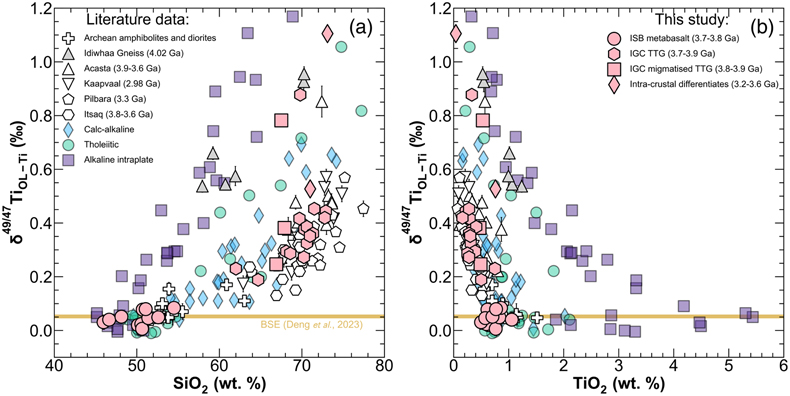
Figure 1 δ49/47Ti compositions of ISB metabasalts, IGC tonalites and intra-crustal differentiates, with other Hadean-Archean rocks, compared to Phanerozoic lavas from different tectonic settings versus (a) SiO2 and (b) TiO2. Literature sources are given in the Supplementary Information, Table S-11.
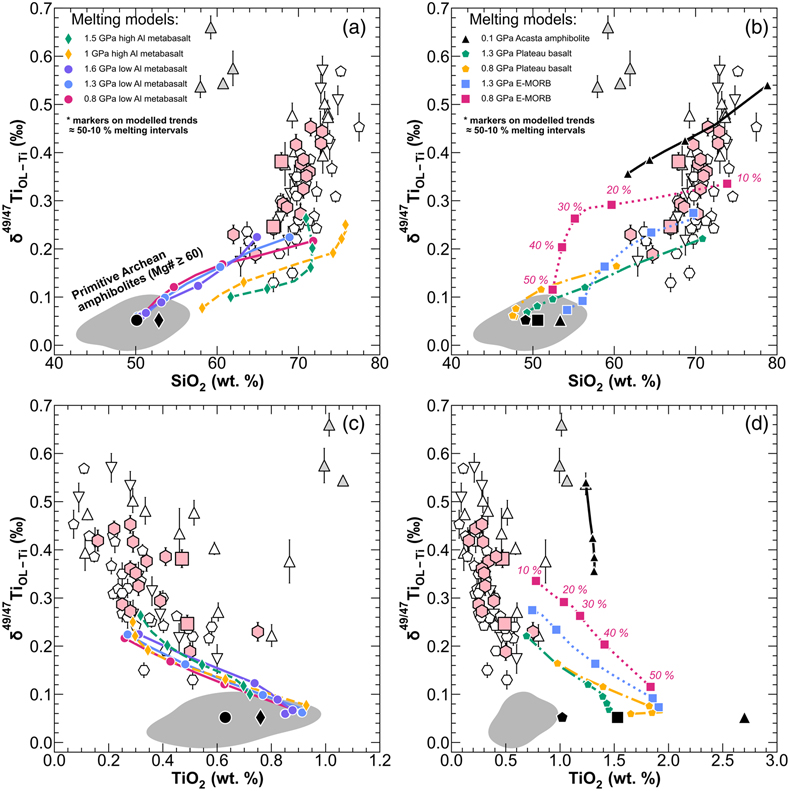
Figure 2 δ49/47Ti versus SiO2 and TiO2 for partial melting of high and low Al Isua metabasalts at 0.8–1.6 GPa (a and c); and partial melting of E-MORB and primitive plateau basalt at 0.8–1.3 GPa (b and d) superimposed on to δ49/47Ti data for Hadean-Archean TTGs (pink, white and grey symbols; see Fig. 1 for the legend). Shaded grey field represents δ49/47Ti range of primitive Archean amphibolites (Mg# > 60) defined by a 0.95 probability density contour. Black symbols indicate the starting composition for each model. Symbols on modelled trends represent melting intervals between 50–10 %. Modelling details are given in the Supplementary Information.
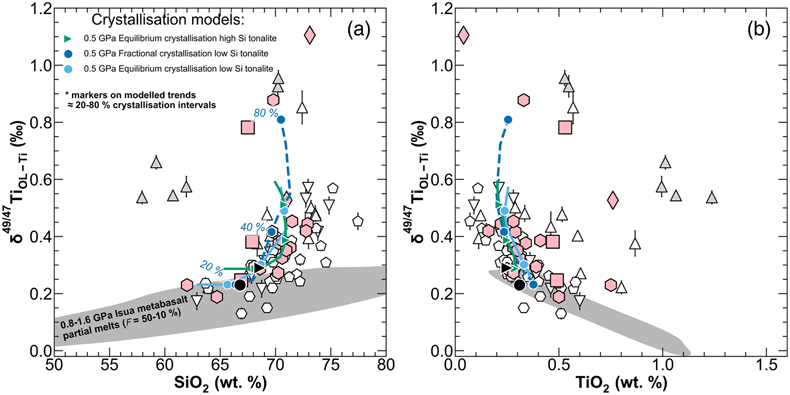
Figure 3 δ49/47Ti versus (a) SiO2 and (b) TiO2 for equilibrium (solid lines) and fractional crystallisation (dashed line) of tonalitic melts at 0.5 GPa compared to δ49/47Ti of Hadean-Archean TTGs (pink, white and grey symbols; see Fig. 1 for legend). Shaded grey field represents the δ49/47Ti range of modelled 50–10 % partial melts of Isua metabasalts from Figure 2 defined by a 0.95 probability density contour. Black symbols indicate the starting composition for each model. Symbols on modelled trends represent crystallisation intervals between 20–80 %. Modelling details are given in the Supplementary Information.
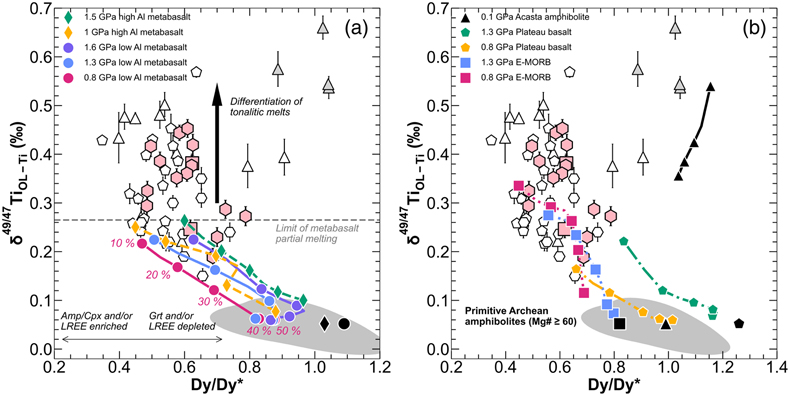
Figure 4 δ49/47Ti versus Dy/Dy* (after Davidson et al., 2013
Davidson, J., Turner, S., Plank, T. (2013) Dy/Dy*: variations arising from mantle sources and petrogenetic processes. Journal of Petrology 54, 525–537. https://doi.org/10.1093/petrology/egs076
) for partial melting of (a) high and low Al Isua metabasalts at 0.8–1.6 GPa, and (b) partial melting of E-MORB and primitive plateau basalt at 0.8–1.3 GPa superimposed on to δ49/47Ti data for Hadean-Archean TTGs (pink, white and grey symbols, refer to Fig. 1 for the symbol legend). Shaded grey field represents the δ49/47Ti range of primitive Archean amphibolites (Mg# > 60) defined by a 0.95 probability density contour. Black symbols indicate the starting composition for each model. Symbols on modelled trends represent melting intervals between 50–10 %. Modelling details are given in the Supplementary Information.

